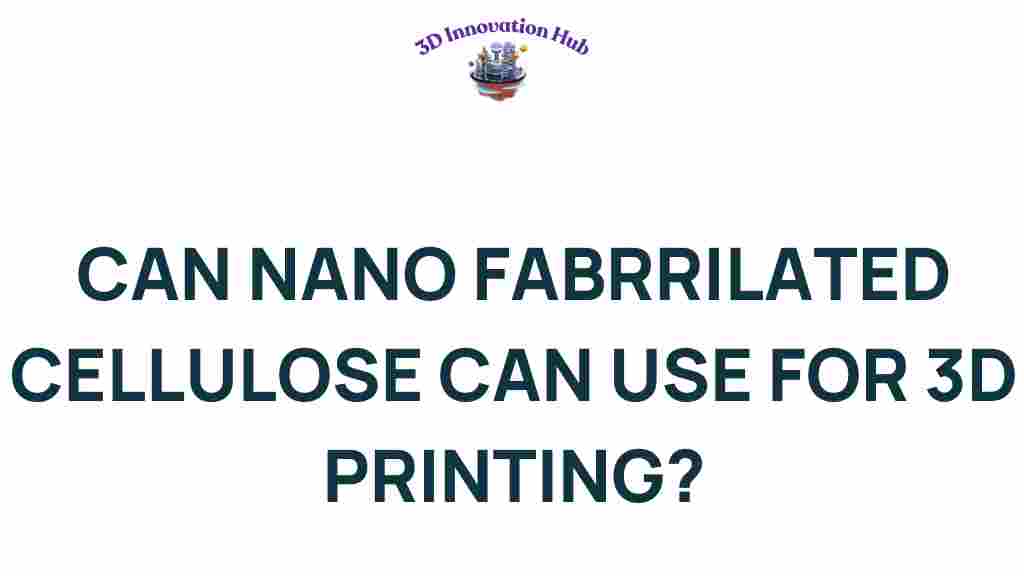Unveiling the Potential: Can Nano-Fabricated Cellulose Transform 3D Printing?
3D printing has revolutionized the manufacturing industry by allowing for rapid prototyping and custom production. However, the materials used in 3D printing can often be unsustainable and environmentally damaging. Enter nano-fabricated cellulose: a potential game-changer in the realm of 3D printing, offering a sustainable alternative that aligns with the growing demand for eco-friendly solutions. This article explores the innovation and technology behind nano-fabricated cellulose, its applications in advanced manufacturing, particularly in bioprinting, and how it could reshape the future of 3D printing.
Understanding Nano-Fabricated Cellulose
Cellulose is the most abundant organic polymer on Earth, primarily derived from plant cell walls. When nano-fabricated, cellulose is broken down into nanofibers or nanoparticles, enhancing its properties and making it suitable for various applications, including 3D printing.
Why Choose Nano-Fabricated Cellulose for 3D Printing?
Here are several compelling reasons to consider nano-fabricated cellulose in 3D printing:
- Sustainability: Being a natural polymer, cellulose is biodegradable and renewable, making it a perfect candidate for eco-friendly solutions.
- Strength and Durability: Nano-fabrication enhances the mechanical properties of cellulose, providing strength comparable to traditional plastics.
- Versatility: Nano-fabricated cellulose can be tailored for various applications, from consumer products to biomedical devices.
- Safety: It is non-toxic and safe for use in bioprinting, where materials must be biocompatible.
Applications of Nano-Fabricated Cellulose in 3D Printing
The integration of nano-fabricated cellulose into 3D printing opens up a plethora of applications across various fields:
1. Advanced Manufacturing
In advanced manufacturing, nano-fabricated cellulose can be used to produce lightweight yet strong components for automotive and aerospace industries. The advantage of using cellulose over conventional materials lies in its lower environmental impact and the ability to create complex geometries with less waste.
2. Bioprinting
In the field of bioprinting, nano-fabricated cellulose offers a promising solution for creating scaffolds that support cell growth. Its biocompatibility and ability to mimic natural tissues make it ideal for applications in tissue engineering and regenerative medicine.
3. Consumer Products
From packaging materials to household items, nano-fabricated cellulose can be used in producing sustainable consumer products. Its biodegradable nature means that products made from cellulose have a reduced environmental footprint.
4. Construction Industry
In the construction industry, nano-fabricated cellulose can be mixed with other materials to develop eco-friendly building materials. These materials could provide insulation and structural integrity while being lightweight and sustainable.
Step-by-Step Process of 3D Printing with Nano-Fabricated Cellulose
The process of 3D printing with nano-fabricated cellulose generally involves the following steps:
Step 1: Material Preparation
Start by sourcing high-quality nano-fabricated cellulose. This can be obtained through various methods, including mechanical, chemical, or enzymatic processes that break down cellulose into nano-sized particles.
Step 2: Mixing with Other Materials
To enhance the properties of the cellulose, it may be beneficial to mix it with other biodegradable polymers or additives. This will improve the flow characteristics during the printing process.
Step 3: 3D Printing Setup
Load the prepared cellulose mixture into a 3D printer. Ensure that the printer is calibrated correctly to handle the unique properties of the nano-fabricated cellulose.
Step 4: Printing Process
Begin the 3D printing process. Monitor the extrusion and layering of the cellulose to ensure consistent quality. Adjust the temperature and speed as necessary to optimize the print quality.
Step 5: Post-Processing
After printing, the final product may require post-processing, such as drying or curing, to enhance its mechanical properties and durability.
Troubleshooting Tips for 3D Printing with Nano-Fabricated Cellulose
While working with nano-fabricated cellulose, you may encounter some challenges. Here are some troubleshooting tips:
- Print Clogging: If the nozzle clogs, consider reducing the cellulose concentration or adjusting the temperature.
- Layer Adhesion Issues: Ensure that the print bed is properly heated and consider increasing the extrusion temperature to improve adhesion between layers.
- Weak Prints: If the printed object appears weak, try increasing the cellulose content in the mixture or adjust your print speed.
The Future of Nano-Fabricated Cellulose in 3D Printing
The potential of nano-fabricated cellulose in the 3D printing industry is immense. As technology advances, we can expect further innovations that enhance its properties and broaden its applications. The combination of sustainability and advanced manufacturing will likely lead to an increased demand for eco-friendly solutions, making cellulose a cornerstone material for future developments.
Conclusion
In conclusion, nano-fabricated cellulose presents a transformative opportunity for the 3D printing industry. Its sustainability, versatility, and favorable properties make it an ideal material for a wide range of applications, from advanced manufacturing to bioprinting. As the world moves towards more sustainable practices, the incorporation of eco-friendly materials like cellulose in innovative technologies will be crucial. With ongoing research and development, we can anticipate a brighter, greener future for 3D printing.
For more information on sustainable materials and advanced manufacturing techniques, visit this resource. To learn more about the latest trends in 3D printing, check out this article.
This article is in the category and created by 3D Innovation Hub Team
